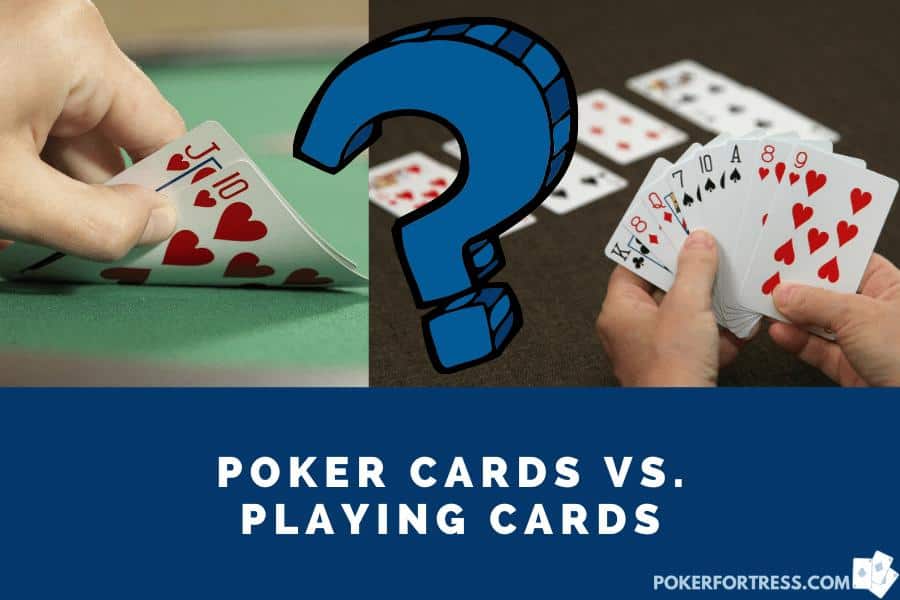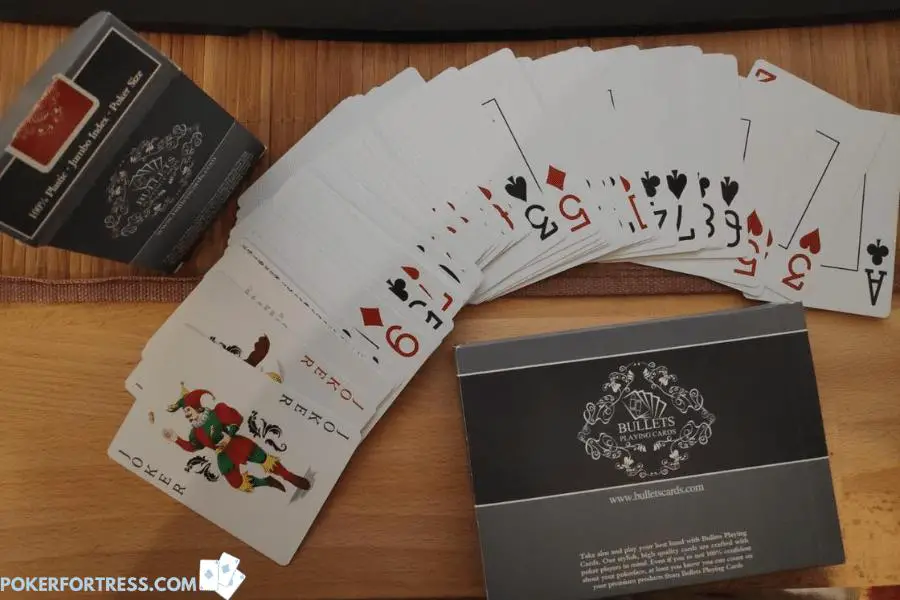Cards and chips are two of the most important things that you need to play poker. As long as you have these two, you can already start playing poker—even without a table, buttons, or a dealer. However, choosing the right poker card may not be as easy as you think because there are two options: poker cards and playing cards.
The main difference between poker cards and playing cards is the size. Poker cards are 2.5in (6.4cm) wide and 3.5in (8.9cm) tall, while narrow bridge playing cards are 2.25in (5.72cm) wide and 3.5in (8.89cm) tall. It may be a small difference in size, but it can significantly impact how you play games.
Since they have different sizes, it’s essential to understand why one is better than the other. We’ll cover everything in great detail and explain why poker cards are the usual pick for most card games. Stick around to learn more about it, and find a better deck of cards for your games.
Playing Cards in a Glance

A narrow bridge playing card is a type of card that is specifically for games that require players to hold several cards simultaneously. A difference of only 0.25 in (0.64 cm) in size may be insignificant, but if you were to create a fan using narrow bridge cards, it’d be easier and more comfortable than holding a standard card.
It’s a smart compromise, allowing players to have as many cards as possible while having just enough real estate in the card for print. It also eliminates the need for players to create multiple layers of cards just to have enough space to spread the cards well enough to see its value.
Most people who have played a card game may not be familiar with this card’s size because we tend to use two or three layers of cards when necessary. You know this when you try to hold 13 cards at the same time while playing bridge. If you’re using poker-size cards, it always requires a “second floor” of cards to have enough space.
Narrow bridge playing cards are made specifically for that purpose. It lets you hold 13 cards with only one fan and still be comfortable to hold. You don’t have to push each card too far because the value is more visible, even with minimal space. Despite being a less popular card type, many people still use it for games that require players to hold several cards.
Pros and Cons of Playing Cards
Narrow bridge size cards aren’t as popular as poker cards, but many people still use it for their games. Here are some of the reasons why using bridge playing cards will be beneficial for you:
- Players can hold 13 cards comfortably without requiring fancy card organizing.
- Prints are optimized for smaller views, making it easier to create smaller fans.
Despite these, using narrow bridge cards isn’t always the best choice for many people because of the following disadvantages:
- It’s not comfortable to hold when players only need a few cards.
- Real estate for print is limited, making the cards less appealing.
- Only a handful of games require players to hold more than 10 cards.
Poker Cards in a Glance
A poker card is specifically for poker games or any card game that doesn’t require players to hold several cards. With the popularity of Hold’em, most poker games only need players to have a maximum of two cards (and 4 for Omaha). We also use this card for almost any game—even bridge.
A poker card’s width is 2.5 in (6.4 cm), which has the perfect balance between holding the cards and having enough real estate for the print. Since most games that we play don’t require us to have as many cards as bridge games do, it only made sense for manufacturers to focus on making cards that are more comfortable to use.

Poker cards are the norm; if you go to a specialty store and vaguely ask for a playing card, they’ll almost always hand over a deck of poker size cards. That’s why it’s the most common type of card that people use and the size that we’re comfortable to use.
Aside from comfort and availability, it also gives the manufacturers enough space to have more details on each card. If you compare a bridge playing card with a poker card, the first thing that you’ll notice is that poker cards have more details on them. That’s because 2.5 in (6.4 cm) has the perfect size for the characters—not too big or too small.
A poker size card is a better choice for those looking for a “general use” card that they can use on almost any game. Even casual bridge players use this size because it’s easier to find in stores. The only downside to using it is that you need bigger hands or be creative when holding cards to hold more simultaneously. It can also be challenging for some people to shuffle a slightly wider deck of cards.
Pros and Cons of Poker Cards
Bridge playing cards are more of a niche product, and many people aren’t even aware of this size. Here are some of the advantages of using poker cards that made it a better choice for many people:
- Easier to hold and use, especially if you only have a few cards.
- The most common type of card that you can get from most stores.
- People are more comfortable playing with cards of this size.
Despite these advantages, poker cards aren’t always the better option. Here are some of the disadvantages associated with using poker cards:
- It’s harder to manage when you’re holding several cards at the same time.
- You’ll need to fan out the cards more to get a clear view of the card’s value.
Which Card Size Should You Choose?
Now that you’re aware of the difference between both cards, which would be a better option for you?
Well, there’s a considerable chance that you’ve already used poker cards while playing with your friends. If you never had problems while using it, and don’t plan on having regular bridge games, then poker cards are excellent. You’ll have more uses for poker cards because most card games that we play don’t require you to hold several cards.
If you are interested to know which cards are the best for poker (and which have the nicest details printed), then check this article.
However, if you’re planning to play more bridge games, getting the bridge playing card is advisable. Although it won’t be as comfortable as holding poker cards, it allows you to play bridge easier. It’s also possible to use it for other card games, even for poker.
Another factor that you may want to consider is the comfort in shuffling these cards. In general, men find it easier to shuffle wider cards because it fits their hands, while women prefer narrow cards when shuffling. Although it doesn’t really have as much impact, it’s also something that you may want to consider when choosing between the two.
There’s really not that much difference between playing cards, and you’ll definitely find both of them easy to use. It’s only a matter of the type of game you’re more inclined to play using these cards and the comfort you get while using them.
Conclusion
The only difference between poker cards and playing cards is the size. However, it has the potential to affect the games that we play and the comfort that we get while playing. A difference of 0.25 in (0.64 cm) in width may not sound much, but it makes a lot of difference when you’re holding several cards.
You can use both cards for any card game, but bridge playing cards are a better option for you if you’re planning to have more bridge games. On the other hand, poker cards are a better choice if you’re only looking for a “general use” card that you can use for any game.



